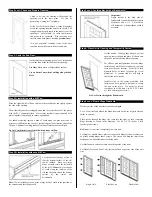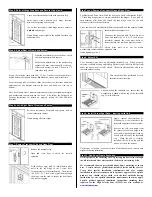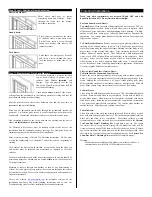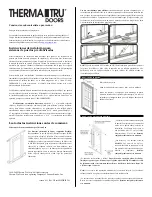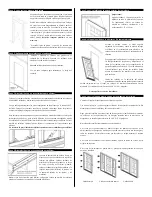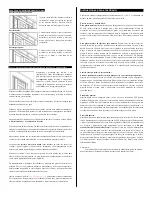
Step 2 cont.: Check and Prepare Opening.
Check to be sure the framing walls around the
opening are in the same plane. Do this by
performing a “string test” for plumb.
String Test for Plumb: Attach a string diagonally
across the opening from the outside, as shown. The
string(s) should gently touch in the center, if not the
opening is “out of plumb” by twice that distance
and needs to be corrected. Flip the string over
itself to check both planes.
Fix any problems now.
*An “out of plumb” condition is one of the most
common reasons door units leak air and water.
Step 3: Caulk the Sub Floor.
On the sub floor at opening, place 3 very large beads
of sealant. Run beads full width of the opening.
Use Only
Elastomeric or Polyurethane sealant.
Use an Entire Tube when Caulking along the Sub
Floor.
Step 3A: Installation with a Sill Pan.
Place the right and left sill pan ends onto the caulk beads and tightly against
the side of the opening.
Then, liberally coat the overlapped areas and the recessed areas of the pieces
with the PVC cement provided. Place center section(s) in position and hold
pieces together long enough to ensure a good bond.
For added protection, spread a bead of caulk along the glue joints and to
prevent air infiltration, run a bead of caulk along the lower interior edge of the
sill pan. Additional caulking could affect the performance of the sill pan.
Do Not Caulk the bottom of the Sill when using a sill Pan.
Step 3B: Installation without a Sill Pan.
Lay the door unit on edge or face so
that the bottom surface of the sill
can be caulked. Place very large
beads of caulk across the full width
of the sill. Additionally, place beads
of caulk along the junction of the
sill and the jamb and on the bottom
surface of the jambs and
brickmould.
Note:
If a sill extender is used, place a large bead of caulk at the junction of
the extender and the sill approach.
Step 3 cont.: Caulking Back side of Brickmould.
Important!
Apply sealant to the back side of
brickmould around the entire perimeter
of the door unit. A 1/2 – 5/8 inch bead
of Elastomeric or Polyurethane caulk is
essential.
Step 4: Place Unit in Opening and Temporarily Fasten.
Lift the unit up. With top edge tilted away from
opening, center the unit and place sill down onto
sill pan or caulk beads and tilt into opening.
For all door unit configurations, note the hinge
locations and mark those locations on the jamb
faces near the door surfaces. Pre-drill 1/8 inch
diameter holes at these locations for screw
placement. A counter sink bit will help to
conceal the screw heads.
Install screws in the center pre-drilled hole
locations on both jambs to
temporarily
secure
the unit in the place. Do not drive screws
completely in at this time. Use #8 X 2-1/2 inch
or 3 inch exterior grade screws.
Do Not Fasten through the Brickmould.
Step 4 cont.: Plumb Hinge Side Jamb.
Work from side of the door that is weather-stripped.
Use a 6 foot level and plumb the hinge side jamb both ways (right to left and
inside to outside).
Place screws through the hinge side jamb into the studs, at each remaining
hinge location, as shown in the diagrams. Use #8 X 2-1/2 inch or 3 inch
exterior grade screws.
Do Not,
drive the screws completely in at this time.
For Single or Double Doors, place screws at each hinge location, so shims can
be placed behind hinges above screws. The screws will keep the shims from
falling down while adjustments are being made.
For Sidelite units, fasten the jamb on the hinge side of the door.
For Double Door and Patio Units, fasten the fixed or passive side of the unit
first.
Single Unit Sidelite Unit Double Unit


